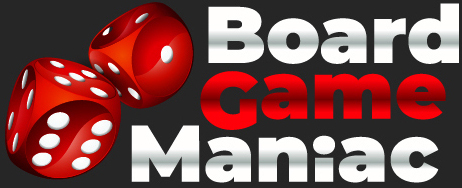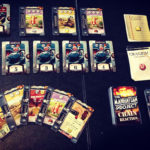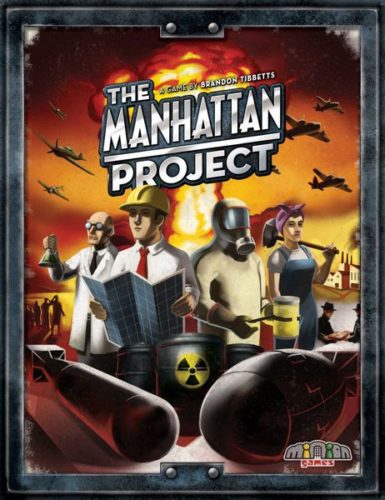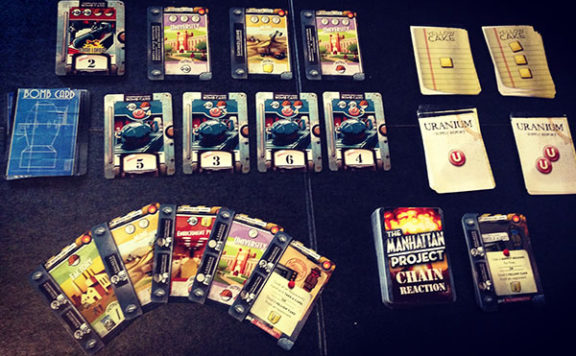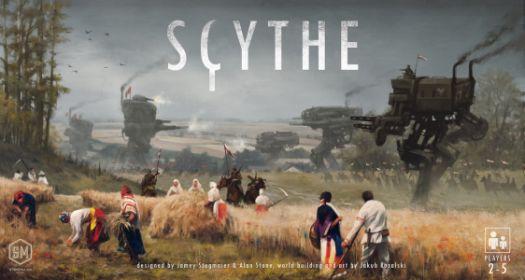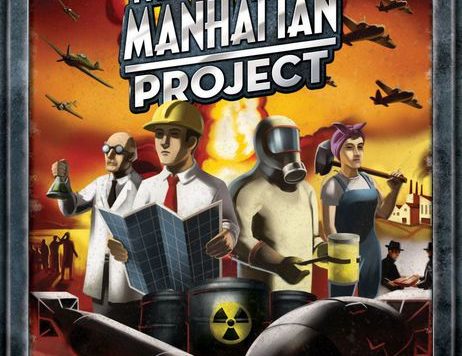Worker placement games usually have to do with quite peaceful subjects but this is not the case in today’s game in review: “The Manhattan Project”. For those unfamilar with the term, you should know that this is the codename given to the project that led to the production of the first nuclear weapons, during World War II. So, in this game, you take the role of a nation pursuing to be the world’s dominant superpower. In reality, you take the role of your nation’s leader of the atomic weapons program, trying to build, test and load the best atomic bombs. Your weapons at hand, however, will not only be research and development but also espionage and sabotage of the other nations’ plans.
As always we’ll first make a quick overview of the game’s rules, before giving a score to our usual scoring categories.
Goal of the game
The goal in Manhattan Project is to gain a specific number of victory points, depending on the number of players. Points are awarded mainly for building, testing and loading bombs. But what would someone need to build a bomb? As in real life, workers and resources are all you need. There are three types of workers in this game: Laborers, Scientists and Engineers. Players start out with only four laborers of their chosen color but can acquire up to four Scientists and four Engineers during the course of the game, by sending Laborers in Universities. There are also four extra workers of each type, that any player can hire as contractors and come in grey color. Resources needed to build a bomb are special fuel in the form of plutonium and enriched uranium. The source of this fuel is natural uranium ore, called “yellowcake”. Players acquire yellowcake by assigning workers to mines.
Game flow / available actions
Each turn a player must choose either to place workers or to retrieve workers.
If one chooses to place workers, he/she has to follow two steps:
- Place a worker on the Main Board, then
- Place workers on any number of buildings on his player board. When placed on a building, a worker immediately performs the action indicated on the card. You must repeat this step until you have no more workers to place.
A space on the board or a building may require any type of worker to be placed on it or a specific one. Apart from workers, you may have to pay money or / and yellowcake in order to perform an action. When placing a worker on a space, you immediately take the benefit written on the bottom of the space.
If one chooses to retrieve workers he must follow the following actions, in order:
- Return all of his permanent Workers from the Main Board and all Player Boards to his personal supply.
- Return all Workers on your Buildings, Bombs, and Implosion Test counters to their appropriate supplies. Contractors return to the General Supply. Permanent Workers return to their owners’ personal supplies.
- Return all contractors on the Main Board and his personal supply to the General Supply.
Maximizing production
In order to maximize production, players can build their own buildings and assign workers to them afterwards. The upper part of the main board is where the building market is, with 6 different buildings available to build anytime. To acquire a building, a player must assign a worker to the Construction space on the board and then pay the appropriate amount of money according to the space the building card occupies on the building market. The first two buildings in the row can also be bought for free if an engineer is put on the construction space on the board. Each time a building is acquired by a player, its slot is replenished by a new card from the top of the stack of building cards. A player’s buildings are placed on his player board and can be immediately used. In order to use a building there are specific requirements, which are shown at the top of the card. These requirements always include workers (of any type or specific type) and may also include money and yellowcake. The benefit of using a building is shown at the bottom of the card and may include the acquisition of more workers, money, yellowcake, fuel or aircrafts.
Going the aggresive way
On the players’ boards apart from building spaces, we can see two aircraft tracks , one for bombers and one for fighters. Each player starts out with only one bomber and fighter and may gain more by assigning workers to factories. Whenever you feel strong enough for some hot air fights, you can assign a worker at the Air strike space on the board and then make any number of Air Strikes you want to whoever opponent you want. Fighters are used to fight other fighters or bombers whereas bombers are used only to damage buildings. In order to be able to send bombers to an opponent’s buildings, one must first eliminate all of his fighters. By spending one fighter, one enemy aircraft is destroyed and by spending one bomber, one point of damage is done to an enemy building. Damaged buildings cannot be used by any player, however workers already there can be retrieved (they hear the sirens and go to underground bunkers to hide). Damaged buildings can be repaired by assigning a worker to the Repair space on the board.
The other way to go aggressively on your opponents is espionage. By assigning a worker to the Espionage space and paying 3$, the active player moves up his marker on the spy track. Then he is allowed to recruit spies and send workers to his opponents’ buildings as well as his own, during the 2nd step of this turn. The number of workers you can each time send to your opponents’ buildings is equal to the number of spies you have.
The Manhattan Project features a medium-to-small main board where players put their workers to work in many different places. These are:
- Construction, in order to acquire buildings
- Air Strike, to launch any number of air strikes to opponents
- Repair to repair damaged buildings. You must pay 5$ in order for three points of damage to be removed. After that, other players may also repair their buildings for an increased cost.
- Factories where you can produce aircraft or money
- Mines, where you can produce yellowcake
- Universities, where you can produce workers. Workers are taken from the General Supply and may be permanent ones or contractors. When retrieving workers, permanent workers go in the player’s supply, whereas Contractors return to the General supply.
- Design Bomb. The player who assigns a worker here, takes the face-up bomb cards, chooses one and passes the rest of the cards to the player on his left. Each player, in turn, chooses a bomb and passes the rest to the left. The player who initiated the procedure has the benefit of acquiring the last bomb card that remains after everyone has chosen a card.
- Reactor and enrichment plant where you can produce plutonium and enriched uranium. On the mainboard there are two different tracks to record your progress towards acquiring these two resources.
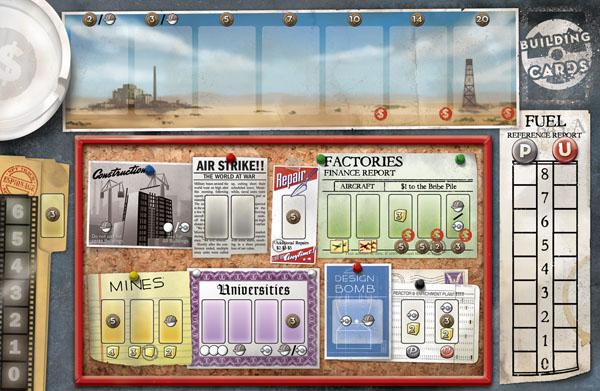
Constructing a bomb
Bomb cards have certain requirements on them regarding workers and fuel in order to be constructed. There are two kinds of bombs: those that use Plutonium as fuel and those that use Enriched Uranium. The former ones have an extra value if you perform an implosion test once. The bomb used for the test is lost but after that, all bombs that use Plutonium as fuel are worth more points. Enriched Uranium bombs don’t require an implosion test and have a fixed point value.
Now, let’s go through our usual scoring categories:
Components:
The Manhattan Project features a rather small mainboard, that efficiently accommodates all worker placement spaces, taking advantage of every inch of space available. It’s obvious that a lot of thought has been spent to the layout and design of the gameboard, which is one of the most thematically appealing I’ve ever seen. For example, the bribe pile, in which money is gathered after placing workers in specific spaces, is located in the top left corner of the board and has the form of an ashtray (yes, smoking has been very popular back then!). The central part of the board has the form of a noticeboard, and every worker placement space available on it, is a note pinned on the noticeboard. The result of this retro design is so up to the point that I consider it one of the most elegant and sufficiently designed gameboards.
The building and bomb cards are made of hard, glossy, high quality cardboard but as I am a sleeve nerd, I chose to sleeve them just in case. The money tokens, airplanes, implosion test counters and various other markers are all made of heavy cardboard of very good quality. Player markers and yellowcake cubes are made of wood.
The player boards feature on the top, the airplane tracks, one for the bombers and one for the fighters. Below them are ten spaces for player’s buildings although these don’t prevent you from building more. These boards are also from thick cardboard.
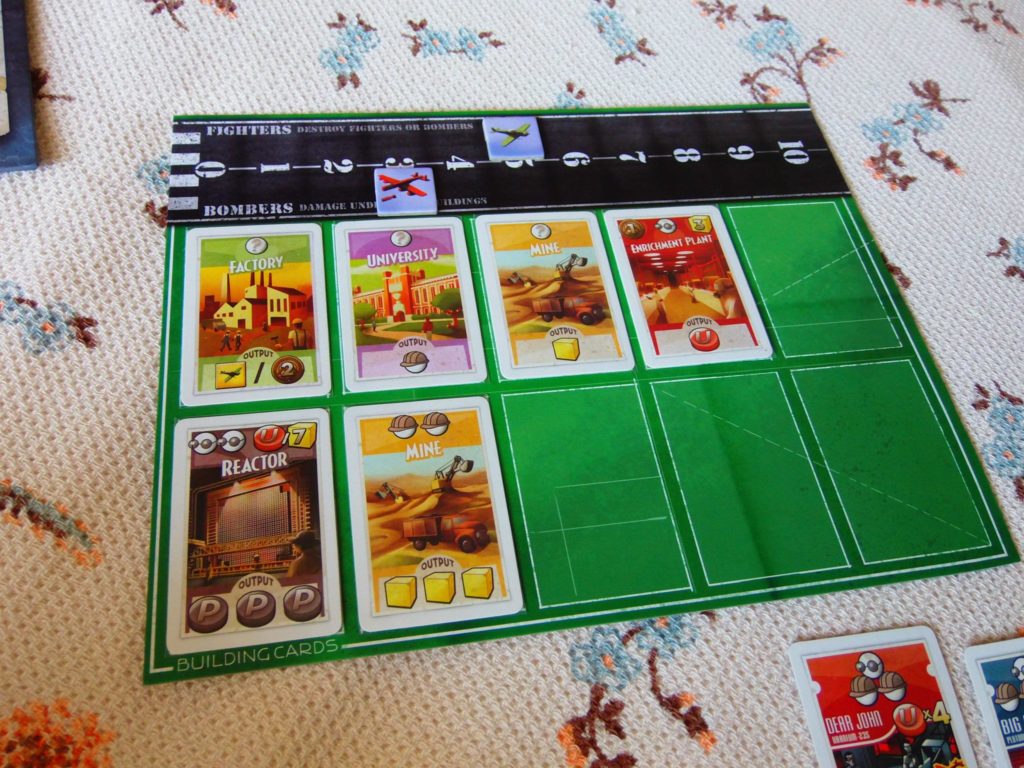
Last but not least, the workers!! Well these are made from the thickest cardboard I’ve seen in a game, although their edges seem a bit vulnerable. Worker tokens are rectangular with an image of the specific kind of worker drawn on it. I love the way the three different kinds of workers are portrayed. It is really very easy to distinguish them: the scientist wears a white robe and glasses, the engineer wears a safety helmet and holds a writing pad and the laborer wears a working suit. This is the first game I played where workers are not all of the same kind and it felt really refreshing. All in all a big thumbs up regarding components. There’s nothing I’d wish to be done differently. 10/10
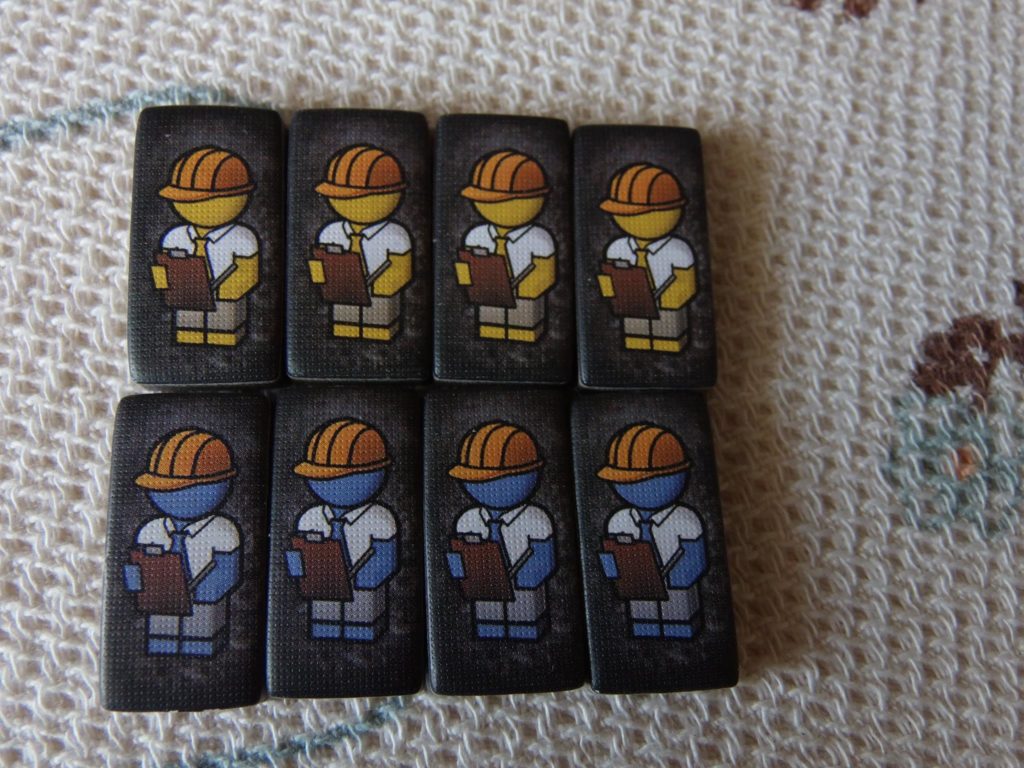
Gameplay:
Manhattan Project’s gameplay is its strongest point. I liked very much the fact that in each and every game there is a very thin line between winning and losing. One must be very focused and make constantly tough calls in various matters: what buildings to buy and what is the right time to buy them according to their place on the marketplace, whether to use airstrikes or not, where to place workers on the board and more. The game ends abruptly when someone acquires the points required for victory. Many times you will find yourself in the verge of winning in the next round or two, only to end up losing as someone else manages to gather the points for the win before you.
There are many ways to play this game whether you like an aggressive style or not. Players may choose to work their ways without interfering in opponents’ plans and the game works out excellently so. For those who like aggression, the game gives you more than one ways to hurt your opponents. You can directly make airstrikes with your fighters and bombers and damage opponents’ buildings, forcing them to lose valuable time and resources to repair them. For even more frustration from your opponents, you can use your spies to take advantage of their buildings. The worst is that they won’t be able to use these buildings that round. Sheer delight!
In most worker placement games, workers are returned to their owners at the end of a round. This game uses the worker placement mechanic in a whole new way. The fact that you can either place a worker or take them all back in your round, enhances the strategic aspect of the game because this way you have more control over your workers. You can, for example, use this mechanic to take your workers back at the right moment, so as to use espionage on your opponents. From a defensive point of view, you can also choose to take your workers back at a moment, in which your opponents can’t spy on you, probably because they have already used all their workers. So, timing is an important aspect of the game and if not given the appropriate attention may cause you to significantly fall behind in the race for the atomic bomb.
All in all, I find Manhattan Project one of the most interesting and challenging worker placement games out there. 10/10
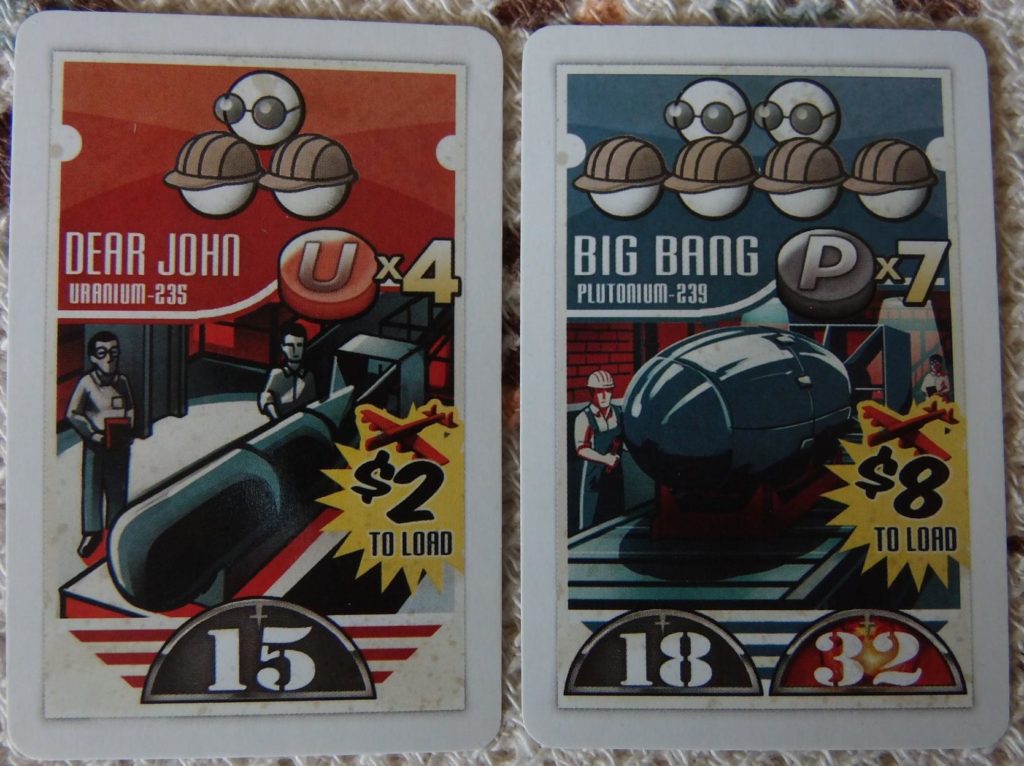
Learning Curve:
The Manhattan Project isn’t an overall difficult game to learn. Like all typical worker placement euros, you must learn what each space on the board is useful for. There aren’t any intricate details in the game that would require special attention or the need to go back to the rulebook often. The rulebook itself is most informative, with a different section for each important aspect of the game and leaves no room for doubts or unanswered questions. If someone else explains the rules to you, you will need about a quarter of an hour to learn the game. 8/10
Theme:
The Cold war theme is represented well enough in Manhattan Project. The gameboard and the rulebook with their retro feel, enhance the sense that you are living in that era of doubt and misbelief. Every action in the game and every worker assignment makes sense in the context of the game and feels thematically correct. The different types of workers are used rationally on the various actions on the board and make you feel you are really distributing work and organizing the whole bomb design process. 8/10
Replayability:
From the first time I’ve played this game, I got immediate hooked and wanted to play many games of it. The fact that there are many ways to achieve victory and the fact that each victory is usually very tight, makes you want to try different strategies each time and see if there is any way to achieve an easier win. 9/9
Fun:
I found “The Manhattan Project” to be a very enjoyable and fun game to play. Its tight gameplay and the ability for direct player interaction are the main sources of fun for me. The quality of the components enhance that feeling (I particularly liked the design of the workers). Although the theme of the game is pretty serious, designing and constructing nuclear bombs has never been so much fun. 8/10
Final Verdict:
Just when I thought I maybe had enough of euros and worker placement games, The Manhattan Project came to stir the water and give new breath to the genre. Everything seems to fall in place with this game, from the quality of its components to the carefully designed rulebook and the tight gameplay. Although it’s not a quick game, the 2 hours of play will flow without noticing, so much involved you will become in the game. The fact I really appreciate in “The Manhattan Project” is that winning or losing is such a close call and every game is a bit different depending on the timing each of the buildings appears in the marketplace queue. As I am kind of an aggressive player, I also enjoyed the player interaction through air strikes and espionage. I am fully recommending this game to all serious gamers and all euro fans that would like to try a different than the usual worker placement game.
Recommended for: euro game fans, worker placement fans
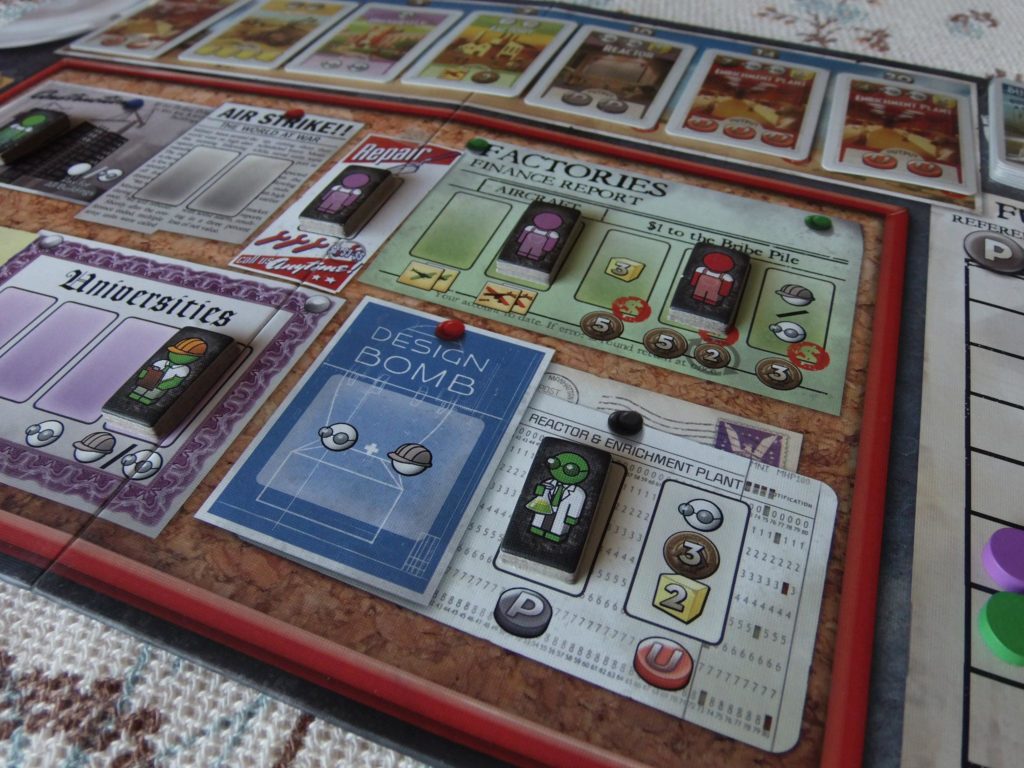
According to our scoring system, scoring categories have different weights. Components have 15% weight, Gameplay 35%, Learning curve 5%, Theme 5%, Replayability 25%, Fun 15%. According to this system and the above scoring in each category, overall weighted scoring of the game is:
Overall: 9.3
If you like the theme of this game you can also checkout “The Manhattan Project: Chain Reaction“.
